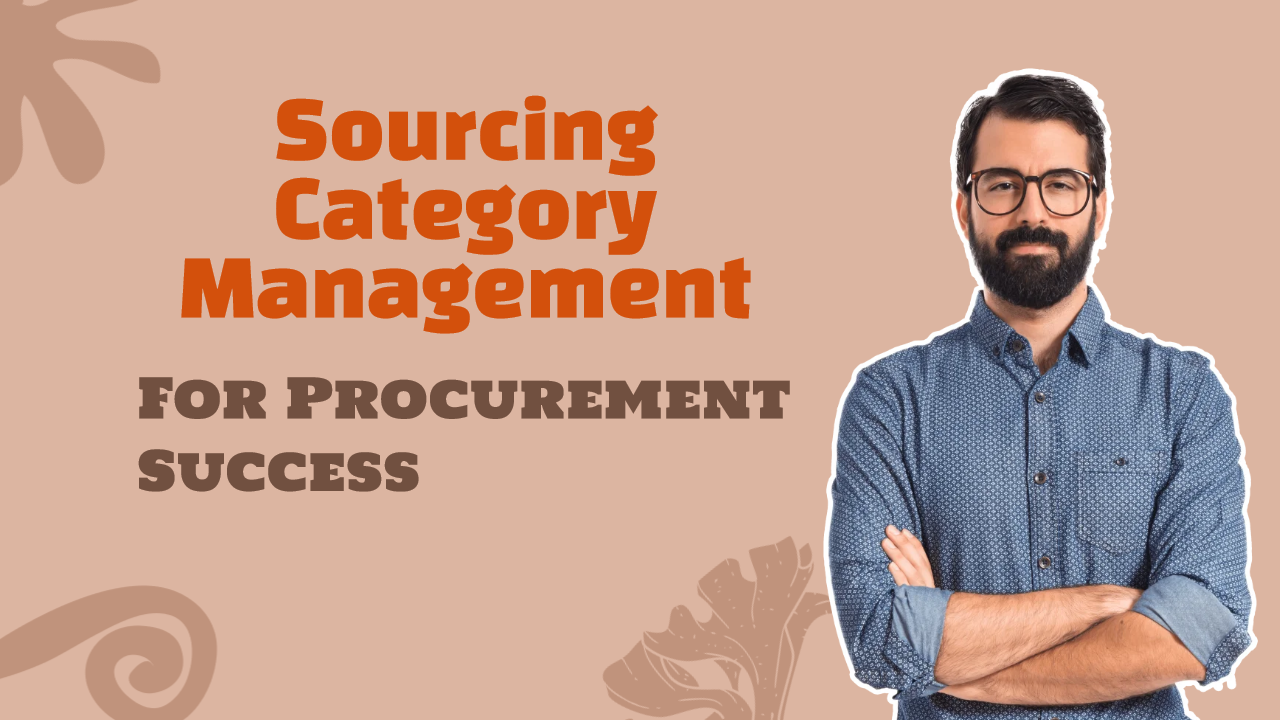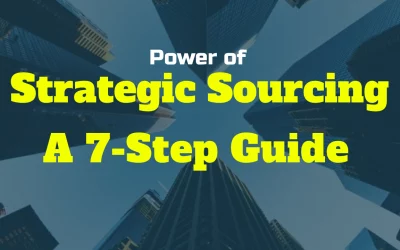When it comes to procurement, businesses are always looking for ways to improve their processes and get more value from their spend management efforts. One approach that has gained popularity in recent years is sourcing category management. At its core, sourcing category management is about optimizing procurement strategies by focusing on specific categories of spend.
By taking a strategic sourcing approach to category management, businesses can achieve significant cost savings, improve supplier relationships, and mitigate supply chain risks. At the same time, effective category management also provides greater visibility into spend categories, which can help inform better decision-making and improve the overall procurement process.
In this article, we’ll take a closer look at sourcing category management and explore its role in successful procurement. We’ll discuss best practices for implementing category management strategies, examine the benefits of this approach, and highlight how category management can contribute to achieving overall business objectives.
Key Takeaways:
- Sourcing category management is a strategic approach to procurement that focuses on specific categories of spend
- By combining strategic sourcing and efficient category management practices, businesses can achieve significant cost savings, improve supplier relationships, mitigate supply chain risks, and gain enhanced visibility into spend categories
- Effective category management requires a deep understanding of the procurement process and a commitment to ongoing improvement
- Implementing category management and strategic sourcing requires careful attention to best practices for developing a category management strategy, conducting spend analysis, managing supplier relationships, optimizing contract management, and engaging procurement teams in the strategic sourcing process
- By leveraging category management as a strategic tool for achieving overall business objectives, businesses can enhance supply chain management, support change management initiatives, streamline business operations, and maximize the impact of their procurement efforts
Understanding Category Management and Strategic Sourcing
A deep understanding of sourcing category management and strategic sourcing is at the heart of successful procurement. These two concepts are often used interchangeably, but they are in fact distinct. Strategic sourcing is an approach to procurement that focuses on identifying opportunities to reduce costs and improve supplier relationships through the analysis of spend data and negotiation of contracts. On the other hand, category management takes a broader view, encompassing the entire lifecycle of the goods or services being procured.
So what is the difference between strategic sourcing and category management? While both approaches share the common goal of achieving successful procurement outcomes, strategic sourcing focuses primarily on short-term cost savings and supplier relationships. Category management, by contrast, looks beyond individual supplier contracts to consider the entire category of goods or services being procured and how they fit into the broader business objectives.
The category management process typically begins with a deep dive into the data surrounding a particular spend category. This involves a thorough analysis of spend patterns in order to identify opportunities for cost savings or process improvements. From there, a category manager will work closely with stakeholders across the business unit to develop and execute a strategy that optimizes the procurement process for that category. This may involve negotiating new contracts, consolidating suppliers, or implementing new processes for managing spend across the business.
So what is the role of a category manager in all of this? At its core, the role of a category manager is to be a strategic partner to the business, driving decisions that align with the organization’s overall objectives. To do this effectively, a category manager must have a deep understanding of the procurement process and the business unit they are working with. They must also be skilled communicators, able to work effectively with stakeholders across the business to drive adoption of new processes and implement change.
The Benefits of Category Management and Strategic Sourcing
Regarding procurement, effective category management and strategic sourcing provide numerous benefits that can enhance business success. Let’s explore some of those benefits below:
Cost Savings
A well-planned category management strategy can lead to significant cost savings by streamlining procurement processes, consolidating spend, and optimizing supplier relationships. By leveraging category management and strategic sourcing, businesses can identify cost-saving opportunities and implement tactics to reduce overall expenses.
Supplier Relationship Management
Another benefit of category management is improved supplier relationship management. Businesses can establish stronger partnerships with their suppliers by engaging in strategic sourcing and category management practices, leading to better quality products, improved delivery times, and more favorable pricing.
Risk Management
Category management and strategic sourcing can also help mitigate risks associated with procurement, such as supply chain disruptions, compliance issues, and quality control concerns. Procurement teams can minimize potential disruptions and increase overall operational efficiency by implementing risk management protocols and establishing clear guidelines for supplier selection and management.
Visibility into Spend Categories
A critical benefit of category management is enhanced visibility into spend categories. By analyzing spending patterns and consolidating spend, businesses can gain clarity and insight into their overall procurement process, allowing for informed decision-making and improved budget management. This visibility also enables businesses to identify opportunities for cost savings and efficiency improvements.
Category management offers numerous benefits for businesses looking to optimize their procurement process. By leveraging strategic sourcing practices and efficient category management strategies, businesses can achieve cost savings, foster better supplier relationships, mitigate risks, and gain enhanced visibility into spend categories. With the right approach, category management can become the secret weapon for successful procurement.
Implementing Effective Category Management and Strategic Sourcing
Implementing a strategic sourcing and category management strategy requires significant planning and coordination across the procurement organization. Our experience has taught us that a successful implementation involves a number of critical steps, including:
Defining a Category Management Strategy
A category management strategy provides the framework for achieving procurement objectives. The different business units within the organization should align on the key spending areas, and procurement teams should develop a strategy for each category. Once identified, categories should be assessed based on their potential for savings and overall impact on the business.
Conducting a Spend Analysis
Before implementing any procurement initiative, it’s important to know where the money is going. A spend analysis provides a clear picture of the organization’s spending habits, which can help identify consolidation and cost-saving opportunities. This analysis also highlights the importance of ongoing data collection and analysis to make informed decisions.
Managing Supplier Relationships
A strong supplier relationship management program ensures clear communication and collaboration with suppliers. It also allows for supplier evaluation and qualification, contract management, and ongoing performance management. Organizations should prioritize regular communication, transparency, and alignment on business objectives to establish successful supplier relationships.
Optimizing Contract Management
Contract management ensures that all supplier contracts are implemented correctly and monitored effectively. Procurement teams should establish clear processes for contract creation, execution, and management. These processes should be streamlined and optimized for maximum efficiency and effectiveness.
Engaging Procurement Teams in the Strategic Sourcing Process
Procurement teams should be involved in the strategic sourcing process from the beginning. Cross-functional teams can help identify potential savings, evaluate suppliers and engage with stakeholders. An inclusive process can lead to better alignment across the organization and ensure buy-in from all stakeholders.
Organizations can achieve significant savings and operational improvements by implementing a strategic sourcing and category management strategy. Effective implementation requires a deep understanding of the procurement process and a commitment to ongoing improvement. Procurement teams must work together to develop a clear strategy, analyze spend data, manage supplier relationships, optimize contract management, and engage with stakeholders. By following these best practices, organizations can unlock the full potential of category management and strategic sourcing.
Leveraging Category Management for Business Success
At its core, category management is designed to optimize procurement processes and drive value for the organization. However, its impact extends far beyond the procurement function alone. By leveraging category management strategies and principles, businesses can improve supply chain management, support change management initiatives, and achieve their overall business objectives.
Enhancing Supply Chain Management
Category management can be a powerful tool for enhancing supply chain management. Businesses can strengthen their supply chain and reduce supply chain risk by streamlining procurement processes and optimizing supplier relationships. Category management can also provide greater visibility into the supply chain, enabling businesses to identify areas for improvement and increase efficiency.
Supporting Change Management Initiatives
Change is a constant in today’s business environment, and category management can help organizations navigate these changes effectively. By providing clarity and visibility into spend categories, category management can help teams identify areas for improvement and make strategic decisions that support organizational change efforts. With category management, businesses can pivot quickly and successfully respond to new challenges.
Mitigating Supply Chain Risk
Supply chain risk presents a significant challenge for businesses of all sizes. Fortunately, category management can help mitigate this risk. By developing deeper relationships with suppliers and gaining greater visibility into supply chain operations, businesses can identify potential risks and take proactive steps to minimize their impact.
Streamlining Business Operations
Effective category management can also streamline business operations. By optimizing procurement processes and reducing costs, businesses can redirect resources to core business activities and invest in growth initiatives. Category management can also improve spend management, providing clarity and visibility into spend categories to inform strategic decision-making.
Maximizing the Impact of Procurement Efforts
Finally, by leveraging category management strategies and principles, businesses can maximize the impact of their procurement efforts. Category management can help businesses identify areas for improvement, optimize supplier relationships, and reduce costs, unlocking significant value and driving success across the organization.
Leveraging Category Management for Business Success
At its core, category management is a strategic approach that optimizes the procurement process by segmenting spend categories and developing customized solutions for each category. When combined with strategic sourcing, category management becomes a powerful tool for achieving overall business success.
Enhancing Supply Chain Management
By leveraging category management, procurement professionals can gain a better understanding of how each spend category impacts the supply chain. With this insight, they can develop targeted solutions that enhance supply chain management, such as optimizing inventory levels, improving delivery times, and reducing transportation costs.
Supporting Change Management
Category management also provides a framework for managing change within the procurement organization. By breaking down spend categories, procurement professionals can identify areas for improvement and develop actionable plans for driving change. This approach enables organizations to adapt to evolving business needs and stay ahead of the competition.
Mitigating Supply Chain Risks
Effective risk management is a critical component of successful procurement. Procurement professionals can develop targeted risk mitigation strategies by segmenting spend categories and identifying potential risks within each category. This approach helps organizations minimize the impact of unforeseen events on their supply chain, ensuring uninterrupted business operations.
Streamlining Business Operations
Businesses can streamline their operations and reduce costs by optimizing the procurement process through category management and strategic sourcing. By gaining visibility into spend categories, procurement teams can identify areas for consolidation and negotiate better contracts with suppliers. This approach enables organizations to achieve greater operational efficiency and maximize their return on investment.
Maximizing the Impact of Procurement Efforts
At the end of the day, category management is all about maximizing the impact of procurement efforts. Organizations can achieve significant cost savings by adopting a category management approach, foster better supplier relationships, mitigate risks, and gain enhanced visibility into spend categories. This approach requires a deep understanding of the procurement process and a commitment to ongoing improvement.
Conclusion
Strategic sourcing and category management are critical components of successful procurement. By combining these approaches, organizations can optimize their procurement process, enhance supply chain management, mitigate risks, streamline operations, and maximize their return on investment. To implement category management effectively, organizations must be committed to ongoing improvement and must work together to drive change. With the right approach, category management can become the secret weapon for successful procurement.
FAQ
What is sourcing category management?
Sourcing category management is an approach used in procurement to effectively manage and optimize spend within specific categories of goods or services. It involves strategically analyzing and organizing suppliers, contracts, and purchasing data to drive cost savings and improve supplier relationships.
What is the difference between category management and strategic sourcing?
Category management focuses on managing and optimizing spend within specific categories, while strategic sourcing is identifying, evaluating, and selecting suppliers to meet the organization’s needs. While they are related, category management is a broader concept that includes strategic sourcing as part of its implementation.
What is the role of a category manager in procurement?
A category manager is responsible for developing and executing category strategies, conducting market research, identifying new suppliers, negotiating contracts, and managing supplier relationships within their assigned categories. They play a crucial role in optimizing spend, driving cost savings, and ensuring the organization has a reliable and efficient supply chain.
What are the benefits of sourcing category management?
Sourcing category management offers numerous benefits for procurement professionals. It enables cost savings through strategic supplier negotiations and reduced maverick spending. It improves supplier relationships by fostering collaboration and driving supplier performance. It enhances risk management by identifying and mitigating risks within specific spend categories. It also provides spending visibility, enabling informed decision-making and better overall procurement outcomes.
How can I implement effective category management and strategic sourcing?
Implementing effective category management and strategic sourcing requires a strategic approach. It involves developing a category management strategy, conducting thorough spend analysis to identify opportunities, managing supplier relationships through effective supplier relationship management, optimizing contract management, and engaging procurement teams in the strategic sourcing process. Collaboration and continuous improvement are key components of successful implementation.
How does category management contribute to business success?
Category management is a valuable tool for achieving business objectives. It enhances supply chain management by optimizing sourcing and procurement processes. It supports change management initiatives by facilitating strategic alignment and promoting efficiency. It mitigates supply chain risks by identifying and addressing potential vulnerabilities. It streamlines business operations by driving cost savings and improving supplier relationships. Ultimately, category management maximizes the impact of procurement efforts and contributes to overall business success.






0 Comments